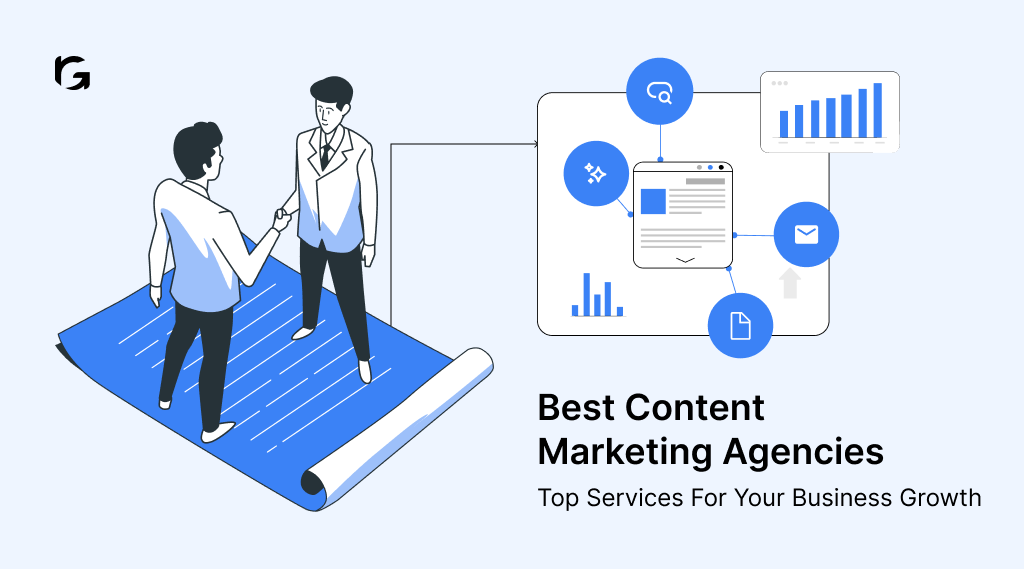Introduction
Having clear and achievable goals is crucial for success. These goals act as guiding stars, helping you stay focused and aligned with your broader business objectives.
Without clear goals, SaaS teams often create content that misses the mark. They waste time, struggle with inconsistent messaging, and fail to engage the right audience. This usually happens when the focus is on output rather than outcomes.
However, setting the perfect content marketing goals can be a daunting task for many. Fortunately, through this article, we are going to simplify the process of entrepreneurs and digital marketers by educating them on 4 key goals of content, 5cs of content marketing, best practices to follow, and answer common queries.
What are the 4 Content Goals?
Content creation serves various purposes, with four primary goals: informing, engaging, persuading, and entertaining. These objectives guide creators in crafting material that resonates with their audience and achieves desired outcomes.
Goal 1: Informing
The first goal of content is to provide valuable information to the audience. Whether it's news articles, educational videos, or instructional guides, informing content aims to enlighten and educate. For example, a news article might inform readers about current events, while a tutorial video might teach viewers how to cook a specific dish. The key is to deliver accurate and relevant information that adds value to the audience's knowledge base.
Goal 2: Engaging
Engaging content captures the audience's attention and keeps them invested in the material. It goes beyond merely presenting information by using storytelling, interactive elements, and compelling visuals to create a memorable experience. For instance, a blog post might include anecdotes or personal experiences to connect with readers on a deeper level, while a social media campaign might encourage user participation through polls or challenges. By promoting interaction and dialogue, engaging content cultivates a sense of connection between the creator and the audience.
Goal 3: Persuading
Persuasive content aims to influence the audience's beliefs, attitudes, or behaviors. Whether it's promoting a product, advocating for a cause, or persuading voters during an election campaign, this type of content seeks to sway opinions and prompt action. Techniques such as testimonials, emotional appeals, and evidence-based arguments are often employed to build credibility and convince the audience of the message's validity. However, ethical considerations are essential to ensure that persuasive content does not manipulate or deceive the audience.
Goal 4: Entertaining
Lastly, content serves the goal of entertainment by providing enjoyment, amusement, or escapism to the audience. This can take many forms, including humorous videos, captivating stories, or visually stunning artwork. Entertainment content seeks to evoke emotions such as laughter, joy, or awe, offering a reprieve from the mundane realities of everyday life. While entertainment may not always have a clear educational or persuasive agenda, it plays a vital role in promoting emotional connections and enhancing the overall content experience.
What are Smart Goals for Content Marketing?
In this smartphone-driven world, you must adopt smart content marketing goals. They help you focus on what you want to achieve and how you'll get there.
Here are five key aspects to consider when setting smart goals:
1. Specific: Your goals need to be clear and well-defined. Instead of saying, "Increase website traffic," you could say, "Increase organic website traffic by 20%."
2. Measurable: You should be able to track your progress and know when you've reached your goal. For instance, if your goal is to generate leads, you could set a target of capturing 100 email addresses within a month.
3. Achievable: Your goals should be realistic and attainable. Setting targets that are too far out of reach can lead to frustration and disappointment. Consider your resources and capabilities when setting your goals.
4. Relevant: Your goals should align with your overall business objectives and be relevant to your target audience. For example, if your business is focused on selling eco-friendly products, your content marketing goals should reflect this by promoting sustainability and environmental awareness.
5. Time-bound: It's important to set deadlines for achieving your goals. This helps create a sense of urgency and keeps you focused. For instance, you could aim to increase social media engagement by 50% within three months.
What are the 5 C’s of Content Marketing?
Content marketing is a strategy many businesses use to reach and engage with their audience. It involves creating valuable and relevant content to attract and retain customers. To set your content marketing goals, you must consider these five important principles known as the 5 C’s: Content, Consistency, Clarity, Credibility, and Customization.
1. Content
Content is at the heart of content marketing. It refers to the substance or material you create and share with your audience. This content can take various forms such as blog posts, articles, videos, podcasts, infographics, and social media posts. The key is to create content that is valuable and relevant to your target audience. It should address their needs, interests, and pain points, providing them with useful information or entertainment. High-quality content can help establish your brand as a trusted authority in your industry and build a loyal following.
2. Consistency
Consistency is crucial in content marketing. It involves regularly creating and publishing content to keep your audience engaged and coming back for more. Consistency helps you maintain a presence in your audience's minds and establishes trust and reliability. Whether you choose to publish content daily, weekly, or monthly, it's essential to stick to a schedule and deliver content consistently. This not only keeps your audience engaged but also helps with search engine optimization (SEO) as search engines favor websites that regularly update their content.
3. Clarity
Clarity is about making sure your content is easy to understand and digest. Your audience should be able to grasp your message quickly and effortlessly. Avoid using overly complex language or industry jargon that may confuse or alienate your audience. Instead, use clear and straightforward language that resonates with your target audience. Organize your content in a logical manner, with clear headings, subheadings, and bullet points to help readers navigate through it easily. Clarity also extends to the design of your content, ensuring that it is visually appealing and easy to read across different devices.
4. Credibility
Credibility is essential for gaining the trust of your audience. Your content should be reliable, accurate, and well-researched. Back up your claims with evidence, data, and expert opinions to establish credibility and authority in your industry. Avoid making exaggerated or false claims that could damage your reputation and erode trust with your audience. Building credibility takes time and effort, but it's worth it in the long run as it helps promote strong relationships with your audience and encourages them to engage with your content and brand.
5. Customization
Customization involves tailoring your content to meet the specific needs and preferences of your target audience. Every audience is unique, with different demographics, interests, and behaviors. By understanding your audience's preferences and pain points, you can create content that resonates with them on a deeper level. This may involve segmenting your audience based on factors such as age, gender, location, or interests and creating content that speaks directly to each segment. Personalizing your content shows your audience that you understand and care about their individual needs, increasing engagement and loyalty. Incorporating these principles before setting your content marketing goals will certainly help you build a strong brand presence, establish trust with your audience, and drive business growth.
8 Best Practices to Set your Content Marketing Goals
Setting clear and achievable content marketing goals is crucial for the success of any business. These goals serve as a roadmap, guiding your efforts in creating and distributing valuable content to your audience. However, it's important to avoid using certain overused phrases that might dilute the effectiveness of your message. Here are key eight practices:
1. Be specific and measurable
Instead of using vague phrases like "Mastering the Art of" or "Unleashing the Power of," focus on specific outcomes you want to achieve. For example, rather than saying, "Mastering the Art of Content Creation," you could set a goal like, "Increasing monthly website traffic by 20% through consistent blog posts." This makes your goals measurable and provides a clear target to work towards.
2. Keep it simple
Avoid using complex phrases like "Demystifying" or "Navigating the World of." Your goals should be easily understandable by everyone involved in your content marketing strategy. A simple and straightforward goal could be, "Increasing social media engagement by 25% in the next quarter."
3. Set realistic goals
While it's important to aim high, setting unrealistic goals can lead to frustration and demotivation. Instead of promising to "Empower Your Knowledge in" or "Elevate Your Understanding of" a particular topic, set goals that are attainable within a reasonable timeframe and with the resources available to you.
4. Focus on actionable steps
Rather than vague promises to "Unlock the Secrets of" or "Embark on a Journey to," break down your goals into actionable steps. For instance, if you want to improve your email open rates, set a goal like, "Optimizing subject lines to achieve a 15% increase in email open rates within three months."
5. Align with business objectives
Your content marketing goals should align with the overall objectives of your business. Instead of generic phrases like "Insider's Guide to" or "A Deep Dive into," tailor your goals to address specific business needs. For example, if your goal is to increase sales, focus on creating content that drives conversions and generates leads.
6. Consider your audience
When setting content marketing goals, it's essential to consider the needs and preferences of your target audience. Instead of focusing solely on your own objectives, think about how your content can provide value to your audience. For instance, if you're targeting millennials, your goal might be to create more visually appealing content for platforms like Instagram and TikTok.
7. Measure progress and adjust accordingly
Once you've set your content marketing goals, regularly monitor your progress and make adjustments as needed. Avoid phrases like "Unleash the Full Potential of" or "Unlock the Hidden Secrets Behind," which imply a one-time accomplishment. Instead, focus on continuous improvement and adapt your strategy based on real-time data and feedback.
8. Celebrate milestones
Finally, don't forget to celebrate your achievements along the way. Instead of waiting until you've achieved all your goals to celebrate, acknowledge and reward progress at each milestone. This helps to keep your team motivated and engaged in working towards the larger objectives.
To wrap up
In setting perfect content marketing goals, understanding the core objectives of content creation—informing, engaging, persuading, and entertaining—is paramount. These goals, when aligned with smart principles and the 5 C's of content marketing, create a robust foundation for success. Entrepreneurs and digital marketers should follow best practices like being clear, keeping things easy to understand, and making sure content goals match business goals. They should also track progress, change strategies as needed, and celebrate successes along the way to reaching great content marketing.
FAQs
Q: What are the primary objectives of my content marketing efforts?
Determine whether your primary goal is to increase brand awareness, drive website traffic, generate leads, nurture leads, increase sales, or establish thought leadership. Your content marketing goals should align closely with these overarching objectives.
Q: Who is my target audience, and what are their needs and pain points?
Understanding your target audience is crucial for crafting relevant and engaging content. Identify their demographics, preferences, behaviors, challenges, and interests to tailor your content to resonate with them effectively.
Q: What key performance indicators (KPIs) should I track to measure success?
Select KPIs that directly reflect progress toward your content marketing goals. These may include metrics such as website traffic, social media engagement, lead conversion rates, email open rates, click-through rates, and content performance metrics like time on page and bounce rate.
Q: How do I ensure that my content marketing goals are specific, measurable, achievable, relevant, and time-bound (SMART)?
Make sure each goal you set meets the SMART criteria:
- Specific: Clearly define what you want to achieve.
- Measurable: Establish metrics to track progress and success.
- Achievable: Ensure that your goals are realistic and attainable given your resources and constraints.
- Relevant: Align your goals with your business objectives and target audience needs.
- Time-bound: Set deadlines to create a sense of urgency and accountability.
Q: How can I continuously optimize my content marketing strategy based on performance data?
Regularly analyze performance data to identify trends, strengths, and areas for improvement. Use insights gained from analytics to refine your content strategy, adjust goals if necessary, and optimize your tactics to better resonate with your audience and drive desired outcomes.Our experts can hep you get the most out of your content strategy. Connect with us!



.svg)

.png)

.webp)